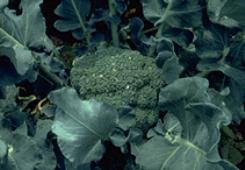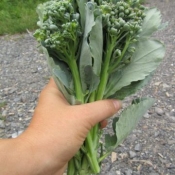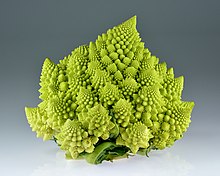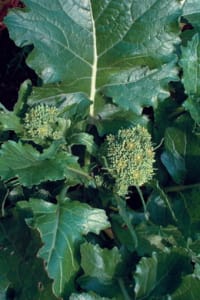Owing to the screen size of your device, you may obtain a better viewing experience by
rotating your device a quarter-turn (to get the so-called "panorama" screen view).
|
This page updated for 2022.
|
Click here for the site directory.
|
|
Please consider linking to this site!
|
Click here to email us.
|
Broccoli
(Brassica oleracea italica)
Cultivars

A superb vegetable when grown to moderate size and eaten fresh (or it freezes well) it is now, one reads, the Number One vegetable in America (so where is the potato?) But try to find taste information on varieties of Number One. Are they all so much alike in taste that it’s meaningless? Hard to believe…
Broccoli can be divided into two broad classes: single-season and over-wintering. The overwintering (or “spring broccoli”) types are for just that: planting in the fall and cropping in early spring. (Many purple types are for overwintering.) Because we have generous freezer capacity, we see no virtue in the overwintering types, which were developed to provide an early fresh green. Just be sure that you don’t inadvertently plant an overwintering type when trying for a regular-season broccoli or you’ll get poor or no crops.
The “standard” season broccolis can be further subdivided, if only roughly, into two other classes. The first produces chiefly a main head and few or no side shoots; the second, often called “sprouting broccoli”, produces a smaller main head and (or but) after that is taken, a considerable quantity of side shoots that keep on coming for some time. The division is rough because even the mainhead types normally produce some side shoots, and even the long-production types have some degree of main head.
Some sources, all anecdotal, prefer this or that variety, but others assert that all, when grown properly, taste pretty much alike. Sigh. Since the home gardener cannot save seed of any brassica, owing to the immense likelihood of disease (growing brassica seed is a difficult process, and all commercial seed is eventually inspected for infection before sale), we are open to hybrid varieties, though we’d prefer open-pollinated types, so as to encourage and sustain the maintenance of a sound gene pool for this (and all) crops. But it is notable that of all the five-star broccolis listed in Cornell’s invaluable Vegetable Varieties for Gardeners database (a dozen as we write), all but one (Calabria—not the same as Calabrese) are hybrids.
For a long time, we made the mistake many amateur Brassica growers make, that of trying to race against summer with cool-weather crops. Even with fairly early plantings, if the crops don’t mature very quickly, the weather gets warm then hot, and your broccoli (or other Brassica) crop is largely or wholly shot.
The answer, especially in this era of continuous global warming, is easy: because all Brassicas are quite tolerant of rather cool to cold weather (some actually need some frosting to achieve peak flavor), one simply plants the seeds in mid to late summer and harvests in late fall or even early winter. If the plants don’t grow as fast as we might like, no harm done because they can withstand the cool/cold weather of late fall and early winter.
There seems no overwhelmingly obvious choice for a good fall broccoli, but after a lot of looking and cross-checking we feel that a good choice, considering quality of flavor, productivity, and (let us never forget) reasonable availability of seeds, is the hybrid Green Magic.
(We are preparing to try an experiment with growing broccoli—in this case, Green Magic—indoors in containers on a staggered planting schedule so as to have fresh broccoli year round. We have a run of about 16' of well-windowed space, and will be trying for lettuce, broccoli, cabbage, radishes, and small Paris-type carrots. Wish us luck…)
For those who might insist on only an open-pollinated broccoli, a couple well worth considering are
Umpqua
and Calabria (this is not the same as Calabrese, apparently a notaby different variety). Another quite good OP is Green Goliath, but seed is getting hard to find.

Then there is Piracicaba (shown at the left): a newcomer, said to resemble a cross between heading broccoli and broccoli raab (see farther below), also fairly early (56 days). The Washington Post garden writer certainly liked it, and so apparently do a lot of other folks, many of whom say it is the best-tasting broccoli they have ever eaten. Another virtue is that, despite a rather small main head (circa ½ cup’s worth), it produces great quantities of larger-than-usual side shoots, which are really its purpose. It provides steady amounts of broccoli for a long season—yet another of its virtues is that it is unusually heat tolerant for a broccoli (which makes sense as it was developed in Brazil) and is actually well suited for spring planting for harvest right on into early winter. We really must try some soon (though not this season).

Another unusual broccoli (sort of…really a distinct vegetable but usually called a broccoli) is the “Romanesco” type, shown at the right. But, while this thing has an interesting appearance and remarkable mathematical properties, it is reported to be finicky to grow, at least for Veronica, the type most commonly offered. The taste is described variously, but “very similar to cauliflower, but with a slightly nuttier, earthier flavor” probably covers it. That does not sound to us worth the grief apparently endemic to growing it; we pass. YMMV.

There is a another broccoli-related vegetable—actually a turnip relative—called broccoli raab (also called by many other names—raab, rapa, rapini, rapine, rappone, turnip broccoli, spring broccoli, taitcat, Italian turnip, Italian mustard), which is a broccoli cousin whose edible parts are the leaves and stalk rather than florets—it’s quite bitter and is either an acquired taste or useful as a very occasional novelty. We’ve done it, and, though we both have some taste for bitters, have decided that this is one we can do without.
For those who do like it, here is a bit more. The primary distinction in cultivars is between so-called “spring” and “fall” types: the fall types are really for overwintering, so really early spring types are what one wants. Per the Cornell database, the choice is simple: Quarantina (reasonably available), shown on the left..
Other curiosities, such as “broccoflower” (a broccoli/cauliflower cross) and the aforementioned Romanesco are of zero interest to us: we have store-bought some, and even grown the Romanesco (some years ago, elsewhere), and found them to be much like the once-touted potato/tomato combination plant—clever, but boring to the taste.
Planting
First, and always with any brassica crop: Remember to rotate your crops! Planting brassicas, of any kinds, in the same ground more often than once every four years runs the risk of clubroot infestation—and once you get that, the ground is useless for up to a decade. Don’t take needless chances, even with “catch crops” of radishes.
Timing
A lot of sources insist that broccoli should be started indoors as seedlings. But they are talking about spring-planted broccoli, which, as we said above, seems for many a useless fight against nature. If we are summer-planting for late-autumn harvest, for us the seeds will go in the ground around mid-July, which is scarcely a time when one worries about poor l’il seedlings getting frosted down. So, obviously, we direct-sow.
For our climate, we should be seeding on July 15th. The nice thing about fall harvest is that we don’t need to be too exact about dates, because the plants can go pretty deep into autumn and early winter. Green Magic is listed as 60 days, but that’s from transplant; from actual direct seeding, it’s more like 80 days, which means harvest should be able to begin around the start of October, and possibly even later—let the plants tell you when they seem ready. And remember that once the broccoli head is harvested, generous side shoots continue to appear till freeze finally kills the plant. Since broccoli is said to be hardy down to the mid-20s, one might well still be cutting side shoots in mid-November. What a change from spring planting!
For Broccoli raab, well, the name of Broccoli raab “Quarantina” translates to “40”, because that’s how many days it takes to grow. That said, think about seeding it a little later than regular broccoli, say around the end of July.
Seeding
Plant seed ¼ to ½ inch deep. In a deep-dug bed, space the plants at about 16" (and as they grow in, they will for a leaf canopy sometimes called a “living mulch” of shade). It is wise to use several seeds at each spot, then thin to the strongest when they emerge.
The Bed
A soil pH of 6.5 or higher is wanted; a soil pH of over 6.8 will help minimize clubroot risks, and a pH up to 7.5 is tolerable, though best yields come in at about 6.5 to 6.8. (Lime, preferably hydrated—as sold in practically any garden shop or decent hardware store—can be used to raise soil pH, but remember that it’s harder to lower pH than to raise it, so don’t get careless: make sure you do your calculations carefully, twice, before applying any lime.) Wood-fire ashes can also be used in place of lime; if you have some, do your homework on quantities to use.
Growing
Side-dress with nitrogen fertilizer when the plants are about half-grown. Be sure to provide ample soil moisture (duh—water well), most especially as the heads are developing. An organic mulch helps keep soils cool and moist and suppress weed growth—or, if you deep-bed garden, the plant leaves should form a “living mulch” over the growing area. Hand-pull or use shallow cultivation if additional weed control becomes necessary.
Heading Broccoli
The green buds develop first in one large, central head, then later in several smaller side shoots. When the main head is fully developed, cut it, leaving 5 to 6 inches of stem attached. The main head will grow with small, tightly closed,all-green buds; it passes the ideal picking stage when the buds start to loosen and separate and the individual individual florets “concat”—that is, start to show yellow. (Broccoli left on the plant too long converts some of its sugars into a type of fiber called lignin, creating stems that will be tough no matter how long the cooking process.)
Obviously, the ideal is to pick the heads just before they start to loosen and yellow. That would appear to require you to possess a crystal ball; in reality, 1) if you watch carefully every day, you eventually—from your occasional misses—acquire enough experience to judge well; and 2) there’s no disastrous loss if you let a head go a little too long, as long as you don’t ever let any go a lot too long. Typical main-head size at readiness is at least 4 to 6 inches in diameter, and often larger. (Late side shoots may reach only 1 or 2 inches in diameter, though sometimes they too are larger, but they are normally bountiful.)
Removing the central head stimulates the side shoots to develop for later pickings. These side shoots grow from the axils of the lower leaves; you usually can continue to harvest plentiful broccoli shoots for several weeks after cutting the main head.
Broccoli Raab
Broccoli raab is grown for its leaves and stem, not its flowers, so watch it carefully, because it is fast-growing—the Quarantinaa type is, as noted above, typically 40 days from direct seeding. (That’s why you plant such fast-growing raabs later than broccoli: you don’t want them coming into maturity in heat, lest they bolt.)
You can harvest broccoli raab all at once or gradually. For “all at once” harvest, plants are ready for harvest when they reach a height of 10-15 inches; cut them at ground level, or—if the stem is hard at its base—wherever the stem tissue ceases to be tough and becomes succulent (with luck, a second or even third cutting may be possible). Alternatively, you can keep the young leaves, flower buds, and stems lightly harvested over a continuous period of two to four weeks—cut the small flower heads before the flower buds open (these flower
heads usually average about 1 to 1½ inches in diameter).
(In cooking, the leaves, stems, and any flower heads are normally cooked and eaten together.)
More
Relevant Links
Besides any links presented above on this page, the following ought to be especially helpful:
Odds and Ends
Biology
Broccoli is a member of the Brassica family, which also includes cauliflower (a close relative), Brussels sprouts, kale, rutabagas, turnips, kohlrabi, radishes, and various lesser crops like seakale and the true cresses (notably watercress).
Also, some people seem to have a genetic makeup [archived copy] that makes broccoli (and related plants) taste excessively bitter to them, which is why people can argue about something without realizing it may be a quite different experience for each of them.
History
The people we know as the Etruscans, who came from what is now Turkey, seem to have begun the known cultivation of broccoli—or at least its direct predecessor—almost three thousand years ago; its use eventually spread throughout the Eastern mediterranean area. In the 8th century B.C., the Etruscans began migrating to what is now Italy, and they brought broccoli with them, especially to what is now Tuscany.
The Romans were at once taken with broccoli. Pliny the Elder tells us that the Romans grew and enjoyed broccoli during the first century A.D. The vegetable became a standard favorite in Rome, where the variety called Calabrese—the most common type in the U.S. today—was developed. (Before the Calabrese variety was cultivated, most Romans ate purple sprouting broccoli, a type also still in wide use today.) Apicius, a Roman cookbook author, prepared broccoli by first boiling it and then bruising it “with a mixture of cumin and coriander seeds, chopped onion plus a few drops of oil and sun-made wine”; it was also commonly served with a variety of cream sauces, some cooked with wine, others flavored with herbs.
Broccoli has many strong branches or arms that grow from the main stem, each sprouting a sturdy budding cluster surrounded by leaves (Roman farmers called broccoli “the five green fingers of Jupiter”); unsurprisingly, the name broccoli thus comes from the Latin bracchium—“strong arm or branch.”
Catherine de Medici of Tuscany is said to have first introduced broccoli to France when she went there as the new wife of Henri II in 1533 (she brought an army of chefs and new vegetables as well, and that is said to have been the beginning of France’s rise to culinary significance—the Italians still say they taught the French everything they know about cooking, which is probably an exaggeration, though not a huge one).
By 1724, a British gardening writer referred to broccoli as a stranger in England, and called it “sprout colli-flower” or “Italian asparagus.” When broccoli did arrive in England, in the early 18th century, no one spread the welcome mat. At that time, neither the French nor the English much cared for this vegetable.
Thomas Jefferson was an avid gardener and collector of seeds and plants of fruits and vegetables newly arriving in the United States. He recorded planting broccoli—along with radishes, lettuce, and cauliflower—in 1767. But as early as 1775, broccoli was described in A Treatise on Gardening by a Citizen of Virginia, by John Randolph, who wrote, “The stems will eat like Asparagus, and the heads like Cauliflower.” Despite this encouraging description, broccoli was not much taken up in the U.S. (except by, a little later, Italian immigrants, many of whom who grew and ate it).
Broccoli popularity in the U.S. awaited the D’Arrigo brothers, Stephano and Andrea, immigrants from Messina, Italy; the brothers began with some trial plantings in California in 1922, shipping a few crates to Boston, where they somehow were well received. The time must have been right, for the brothers’ enterprise ballooned; they grew, they advertised by on the then-new radio, and by the 1930s broccoli was an established favorite in the land (many thinking it some newly developed vegetable). Today, it is perhaps the number one vegetable in the U.S. (despite a few persons’ curious distaste for it).
Envoi
Thoroughly famous cartoon from The New Yorker magazine (click the link).
Return to the top of this page.
If you find this site interesting or useful, please link to it on your site by cutting and pasting this HTML:
The <a href="https://growingtaste.com/"><b>Growing Taste</b></a> Vegetable-Gardening Site
—Site Directory—
Search this site, or the web
-
Background Information
about the purposes and design of this site
- Site Front Page
-
Introduction

- An Apologia: why one should cultivate one's garden
- Deep-Bed Gardening (forthcoming)
- Container Gardening (forthcoming)
- Vegetarian and Organic Considerations (forthcoming)
-
Recommended Crops for a home garden, by variety
-
Gardening information and aids
-
Miscellaneous Information of interest to the home gardener
Since you're growing your own vegetables and fruits, shouldn't you be cooking them in the best way possible?
Visit The Induction Site to find out what that best way is!
|
If you like good-tasting food, perhaps you are interested in good-tasting wines as well?
Visit That Useful Wine Site for advice and recommendations for both novices and experts.
|

|
This site is one of The Owlcroft Company family of web sites. Please click on the link (or the owl)
to see a menu of our other diverse user-friendly, helpful sites.
|
|
 Like all our sites, this one is hosted at the highly regarded Pair Networks,
whom we strongly recommend. We invite you to click on the Pair link for more information on getting your site or sites hosted on a first-class service.
Like all our sites, this one is hosted at the highly regarded Pair Networks,
whom we strongly recommend. We invite you to click on the Pair link for more information on getting your site or sites hosted on a first-class service.
|
|
All Owlcroft systems run on Ubuntu Linux and we heartily recommend it to everyone—click on the link for more information.
|
Click here to send us email.
Because we believe in inter-operability, we have taken the trouble to assure that
this web page is 100% compliant with the World Wide Web Consortium's
XHTML Protocol v1.0 (Transitional).
You can click on the logo below to test this page!
You loaded this page on
Friday, 18 April 2025, at 21:16 EDT.
It was last modified on Saturday, 5 February 2022, at 19:39 EST.
All content copyright ©1999 - 2025 by
The Owlcroft Company




